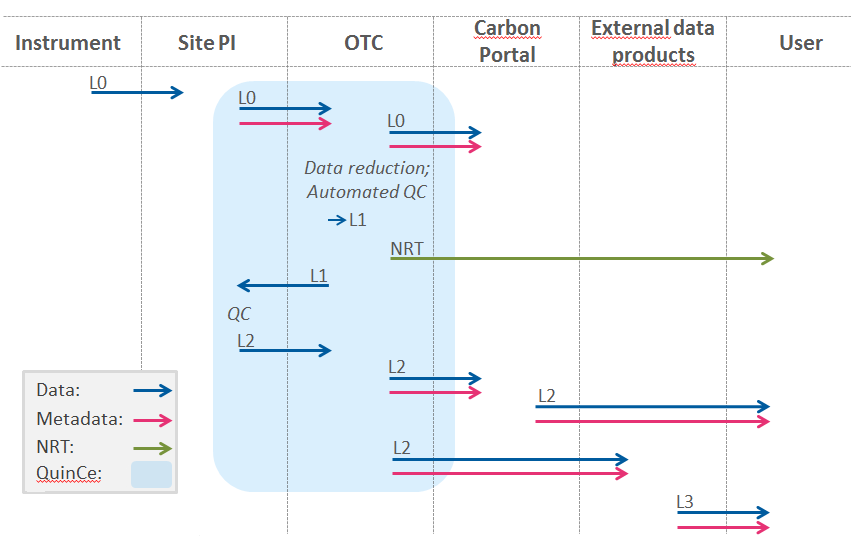The data lifecycle within the Ocean Thematic Centre (OTC) has many steps, including transmissions of data and metadata between the Principal Investigators (PIs), the OTC, and the Carbon Portal (CP) (see Fig. 1). The steps include different levels of quality assurance and control, version control, standardized vocabularies, data archiving, assigning of persistent digital identifiers, and data publications. The OTC will aim to follow international procedures and best practices for the above steps.

Data levels and data quality
The data goes through different levels of quality assurance and quality control:
- Level 0: raw sensor output
- Level 1: data reduction and automatic quality assurance performed
- Level 2: final data set, QCed by PI
- Level 3: elaborated data products using ICOS data
The Level 0 data is uploaded by the PI to an automatic quality control and submission system (called QuinCe) managed by the OTC. To produce Level 1 data, this system will perform data processing (e.g. calculation of fCO2 for carbon VOS stations), data reduction and initial quality control. To produce Level 2 data, the PI will review the Level 1 data and results of the automatic quality control through visualisations and flagging of the data. After a final check of the Level 2 data by the OTC the data will be sent to the CP where it will be published as the final ICOS data. Where this data is used in elaborated products (either from ICOS projects or external efforts such as SOCAT or GLODAP), those products will be called Level 3 data.
From data collection at the sensor until final publication, all standardised processing applied to a dataset is documented. This allows transparent tracking of all procedures applied. OTC will also implement a version control system so that older versions of the data can be restored if needed.
The OTC will also ensure high data quality through encouraging the use of standardised equipment, training of station personnel, and the use of measurement guidelines and standard operating procedures (SOPs). PIs need to ensure that their equipment is operating properly according to ICOS protocols, and that data is submitted regularly to the OTC. Site visits are planned for stations to check compliance to the ICOS standards and determine ways to improve quality. There is an agreed list of targets for accuracy and precision of each measurement.
Data access
Users can access the data from different levels depending on their needs. Users will be able to view near real-time (NRT) visualisations/data (based on the Level 1 data), final quality controlled ICOS datasets (Level 2), and elaborated data products where ICOS data are included (Level 3). Persistent digital identifiers (DOIs) for each accessible version of a data set will be assigned for each level to ensure that data sources, providers, and funding sources are being acknowledged.
The ICOS data is available at the ICOS Data Portal.
